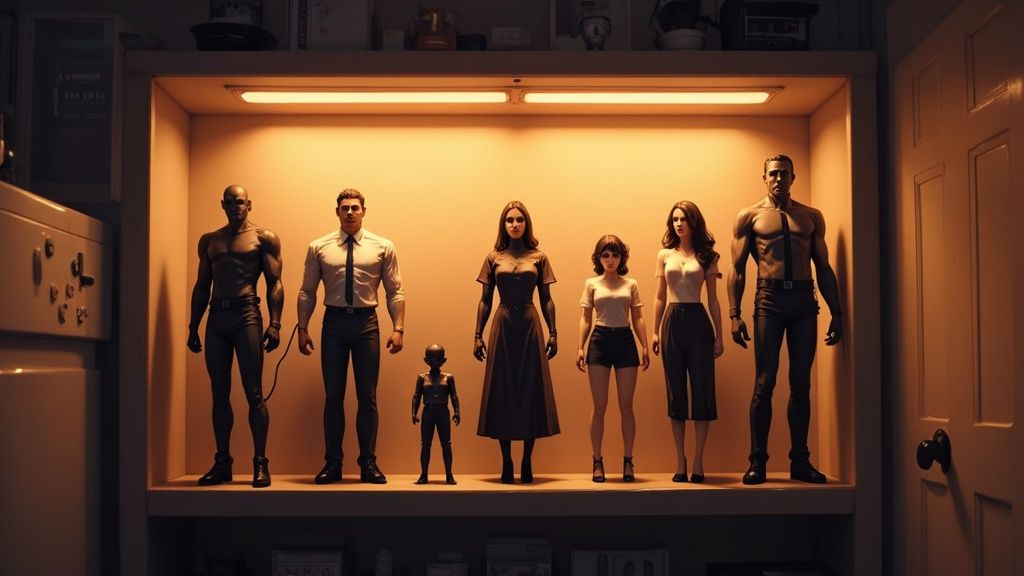An effective anime figures display does more than just show off your collection; it tells a story. It’s the difference between simply owning figures and creating a curated exhibit that protects your investment while bringing your favorite characters to life. This guide will walk you through everything from initial planning to long-term care, helping you create a showcase that is both stunning and sustainable.
Planning Your Perfect Anime Figure Showcase
A fantastic display begins with a thoughtful plan that considers your space, budget, and the overall atmosphere you want to create. This initial planning phase is crucial for transforming a cluttered shelf into an intentional and polished exhibit.
First, carefully assess your available space.
-
Are you working with a single floating shelf, a large bookshelf, or an entire room?
-
The dimensions of your space will dictate the type of display cases you can use and how many figures you can comfortably showcase.
-
Avoid the temptation to cram too many figures into a small area; a well-organized, focused display is always more impactful than an overcrowded one.
1. Defining Your Display's Theme
With your spatial limits defined, you can move on to the creative part: choosing a theme. A strong theme acts as the narrative glue for your collection, turning an assortment of figures into a cohesive and engaging story.
Consider these popular thematic approaches:
-
By Series or Franchise: Grouping figures from the same anime is a classic for a reason. Imagine a shelf dedicated entirely to Dragon Ball, where you can recreate legendary sagas. If you're looking for inspiration, our collection of dynamic Dragon Ball figures shows just how powerful grouping by series can be.
-
By Character or Artist: You might choose to highlight a single character, like Hatsune Miku, showcasing her various designs. Alternatively, you could create a tribute to a specific sculptor whose work you admire.
-
By Aesthetic or Mood: Themes can also be more abstract. Consider a "villains-only" shelf, a display organized by a specific color palette, or a dynamic battle scene that pits heroes from different universes against each other.
2. Budgeting for Your Vision
Finally, it’s essential to establish a budget. A comprehensive display involves more than just the cost of the figures; you must also account for shelving, display cases, risers, and lighting.
Planning your budget from the start helps you make strategic decisions. You might invest in a high-quality, UV-protected case now and add custom lighting later. This phased approach allows you to build an incredible display over time without financial strain.
By mapping out your space, selecting a theme, and setting a budget, you create a clear roadmap. This preparation ensures your final display is not only visually appealing but also a true reflection of your passion as a collector.
Selecting the Right Display Case for Your Figures
Choosing the right display case is a critical decision that extends beyond simple storage. It serves as the stage for your collection, framing your figures, highlighting their details, and protecting them from dust, pests, and accidental damage.
The market offers a wide range of options, from basic bookshelves to custom, museum-quality enclosures. The best choice for you will depend on the size of your collection, your available space, and your budget.
Glass Versus Acrylic: The Great Debate
The primary materials for display cases are glass and acrylic, and each offers distinct advantages.
1) Glass is the traditional choice, favored for its excellent clarity, substantial feel, and high scratch resistance. It is a popular option, featured in collector favorites like the IKEA DETOLF. However, glass is heavy and can shatter, which is a significant concern in households with children or pets.
2) Acrylic is much lighter than glass and far more resistant to shattering. High-quality acrylic can provide superior optical clarity and often includes better UV protection, which is vital for preventing paint from fading. The main drawback is its softness, which makes it more susceptible to scratches and static cling that attracts dust.
For many collectors, the decision involves balancing safety with aesthetics. When displaying valuable or delicate figures, the UV protection and shatter resistance of a quality acrylic case often outweigh the risk of minor scratches.
Display Case Type Comparison
To help you make an informed decision, here is a comparison of common display case types:
|
Case Type |
Average Cost |
Pros |
Cons |
|---|---|---|---|
|
Glass Curio Cabinet |
$100 - $400 |
Excellent clarity, scratch-resistant, premium feel. |
Heavy, can shatter, may lack dust-proofing. |
|
Acrylic Display Box |
$20 - $100 |
Lightweight, shatter-resistant, stackable, excellent dust protection. |
Prone to scratching, can attract static/dust. |
|
Bookshelves |
$50 - $200 |
Budget-friendly, versatile, easily accessible. |
No protection from dust or pests (unless modified). |
|
Wall-Mounted Shelves |
$30 - $150 |
Space-saving, minimalist look, highlights individual figures. |
Limited capacity, no protection, requires secure mounting. |
Ultimately, the "best" case is one that aligns with your collection's needs, your space, and your peace of mind. A well-chosen case is an integral component of your display's overall impact.
Popular Display Case Options
Let's explore some of the most popular choices within the collector community.
-
Glass Curio Cabinets: The IKEA DETOLF is an iconic choice due to its affordable price and all-glass design, which provides a clean 360-degree view. Since many collectors use IKEA furniture, you may find an easy step-by-step guide for IKEA furniture assembly helpful.
-
Acrylic Display Boxes: These are ideal for showcasing a single special figure or creating small, themed groupings. They offer excellent dust protection and are often stackable, allowing for modular arrangements.
-
Bookshelves (Open and Closed): Versatile and budget-friendly options like the IKEA BILLY or KALLAX are excellent starting points. While open shelves provide easy access, they also attract dust. Many collectors modify them by adding custom-fit acrylic doors to combine accessibility with protection.
-
Wall-Mounted Shelves: Floating shelves are a great space-saving solution for a minimalist aesthetic. They place the focus entirely on the figures, eliminating the bulk of a large cabinet.
The nature of the figure can also guide your choice. A delicate resin statue or a rare limited editions piece is best protected in a sealed, dust-proof case. In contrast, a more durable prize figure may be perfectly suitable for a well-maintained open shelf. Investing in the right case is an investment in the long-term beauty and preservation of your collection.
Bringing Your Collection to Life with Posing
A dynamic pose can single-handedly transform an anime figures display from a static lineup into a compelling narrative. This is where you infuse life into the PVC and plastic, capturing the essence of a character's personality and power. It is the art of turning a simple shelf into a captivating diorama.
Start by moving beyond the default, out-of-the-box stance. Consider the character's personality. A stoic swordsman would likely have a composed posture, while a high-energy shonen hero should appear ready for action. Even minor adjustments—such as a slight head tilt, a different arm angle, or a shift in leg position—can significantly enhance the naturalism and believability of the pose.
Creating Dynamic Scenes and Interactions
Posing becomes truly engaging when you arrange figures to interact with one another, weaving individual pieces into a cohesive story. Recreating iconic scenes from anime or manga is an excellent way to create a display that resonates with fellow fans.
Consider these ideas for building scenes:
-
Hero vs. Villain Showdowns: A classic confrontation is always a powerful focal point. Position a protagonist and their antagonist in a dramatic standoff. For example, a clash between two mighty Saiyans can create an incredible centerpiece. This repainted Kamehameha Son Goku figure is designed for such a dynamic pose, perfectly capturing that explosive energy.
-
Team Formations: Assemble characters from the same team or group as if they are preparing for battle or sharing a quiet moment. Grouping figures like the Straw Hat Pirates or the members of Class 1-A can instill a sense of camaraderie and unity in your display.
-
Everyday Interactions: Poses don't always need to be action-oriented. Arranging slice-of-life figures as if they are conversing or laughing adds a layer of personality and charm to your setup.
Using Risers to Add Depth and Focus
A common challenge in any anime figures display is avoiding a flat, cluttered appearance where figures in the back are obscured. Acrylic risers are an invaluable tool for creating visual hierarchy. These simple, transparent platforms can dramatically improve your display's composition.
By placing figures at different heights, you ensure that every character is visible and receives attention. This technique adds vertical dimension, guiding the viewer's eye across the entire scene and making the display feel larger and more organized.
A useful guideline is to place taller figures or those on risers toward the back, with shorter figures in the front. This tiered arrangement creates a sense of depth and prevents your shelf from resembling a crowded lineup. Experiment with different riser shapes and sizes; stair-step risers are ideal for group shots, while individual blocks can highlight a specific character. This simple technique is one of the most effective ways to achieve a professional, curated look.
Illuminating Your Display with Proper Lighting
Proper lighting is the essential element that elevates a figure display from good to breathtaking. Effective lighting makes intricate details pop, while poor lighting can create harsh shadows or, even worse, cause long-term paint damage. Thoughtful illumination is key to making your collection truly shine.
The gold standard for collectors is low-heat LED strips. Unlike traditional incandescent or halogen bulbs, LEDs produce minimal heat, which is crucial for protecting the delicate paint and PVC plastic of your figures. Prolonged exposure to heat can cause warping and paint degradation, so sticking with LEDs is non-negotiable for long-term preservation.
Choosing Your Lighting Temperature and Tone
The type of light you choose significantly influences the mood of your display. The most important decision is the color temperature. It is worth understanding warm white vs. cool white lighting, as it fundamentally alters the perception of your figures' colors.
Here is a quick guide to help you decide:
-
Warm White (2700K-3000K): This soft, yellowish light mimics a traditional light bulb, creating a cozy and nostalgic atmosphere. It is ideal for slice-of-life scenes or figures with earthy color palettes.
-
Cool White (4000K-5000K): This bright, neutral-to-bluish light provides a modern, clean, or futuristic feel. It is excellent for mecha, sci-fi characters, or any display where you want colors to appear crisp and true-to-life.
Some collectors use RGB LED strips to add dynamic color. You could bathe a villain in a menacing red glow or highlight a magical girl with vibrant pink light. For more curated ideas, explore the display styles in our featured collections.
Professional Installation Techniques
Achieving a clean, professional look is all about installation details. The primary rule is to conceal the wires. Run them along the inside corners of your cabinet or use small adhesive clips to keep them hidden. The goal is to make the lighting feel like an integrated part of the display case.
To prevent distracting "hot spots"—where light shines too brightly on one area of a figure—use diffusers. These plastic or silicone channels house the LED strip and scatter the light evenly, creating a soft, gallery-quality illumination across the entire shelf.
Finally, consider placement. Front-lighting is the most common and effective method, as it illuminates your figures without creating harsh shadows. Avoid placing lights directly above or too close to the figures, as this can create distorted shadows and wash out sculpted details. A little time spent planning your lighting will ensure your figures are always seen at their best.
Protecting Your Investment with Long-Term Care
Once you have created a stunning anime figures display, the ongoing work of preservation begins. A consistent care routine is essential to protect your collection from its greatest adversaries: dust, sunlight, and humidity.
This involves more than just occasional dusting; it requires creating a stable and protective environment for your figures. Think of them as investments of both money and passion that deserve meticulous long-term care.
1. The Gentle Art of Dusting
Dust is the most persistent threat to your collection. It settles in small crevices, dulls vibrant paint, and can become abrasive over time. However, aggressive cleaning can cause damage, so a gentle approach is crucial.
Your essential dusting tools should include:
-
Soft-Bristled Makeup Brushes: A fluffy eyeshadow or blush brush is perfect for gently sweeping dust from delicate areas like hair strands, clothing folds, and intricate bases without snagging or scratching the paint.
-
Compressed Air Canister: For hard-to-reach spots, a short blast of compressed air can dislodge dust without direct contact. Be sure to spray from a safe distance to avoid damaging fragile parts with excessive force.
Perform this routine every two to four weeks to prevent significant buildup and keep your display looking sharp. For more complex maintenance, you may find the techniques for customizing and repairing anime figures useful, which always begin with a thorough cleaning.
2. Shielding Figures from Environmental Damage
While dust is a manageable nuisance, sunlight and humidity can cause irreversible damage. Protecting your figures from these elements is non-negotiable for preserving their condition and value.
Direct sunlight is the primary enemy. Its ultraviolet (UV) rays fade paint, yellow light-colored plastics, and make PVC brittle over time. The most important rule is to never place your display case in direct, prolonged sunlight.
A highly effective strategy is to apply a UV-filtering film to your windows. This nearly invisible film can block up to 99% of harmful UV rays, protecting your entire collection without darkening your room.
Humidity is a more subtle threat that can encourage mold growth and cause paint to become tacky. Aim to maintain a humidity level between 40% and 50% in your display room. A simple hygrometer can help you monitor these levels, and a dehumidifier is a worthwhile investment, especially in damp climates.
Taking these proactive steps will ensure your collection remains a source of pride rather than a restoration project. The global anime figure market is expanding rapidly, with projections suggesting it could reach an estimated $3.5 billion by 2033. Protecting your pieces now preserves their value for the future.
Answering Your Biggest Display Questions
As you build your collection, several common questions are likely to arise. You might wonder how to prevent figures from falling or whether you can mix characters from different series. Addressing these details is what separates a good display from a great one.
First, how do you prevent figures from falling over?
This is a common issue, especially with figures in dynamic poses or those with small bases. Ensure your display surface is level, sturdy, and away from high-traffic areas.
For particularly unstable figures, a product called museum putty or museum wax is an excellent solution. This removable, non-damaging adhesive can be applied to the bottom of a figure's base to provide extra grip and stability, offering valuable peace of mind.
How to Mix and Match Figures from Different Series?
Many collectors with diverse tastes wonder if it's acceptable to display figures from different anime together. The answer is a resounding yes—provided you do so with creative intent. A random assortment can look cluttered, but a unifying theme creates a cohesive and visually appealing display.
Consider these unifying themes:
-
Shared Color Palettes: Grouping figures by a dominant color, such as red, blue, or black, can create a highly artistic and striking arrangement.
-
Character Archetypes: Create a shelf dedicated to villains, magical girls, or swordsmen. This approach tells a compelling story by comparing similar roles across different universes.
-
A Tribute to an Artist: If you admire a specific character designer or sculptor, displaying their work together creates a mini-gallery that celebrates their unique style.
The key is to find a common thread that connects otherwise unrelated characters. This allows you to act as a curator, building new narratives that extend beyond the original stories.
Keeping Your Collection Clean and Dust-Free
Finally, what is the best way to clean your figures without causing damage? Dust is a constant challenge, and using the wrong cleaning methods can result in permanent scratches or harm to the paint.
The first rule is to avoid harsh chemical cleaners, as they can strip paint and degrade the PVC plastic over time.
Instead, your primary tools should be a soft-bristled makeup brush and a camera lens air blower. The brush is ideal for gently removing dust from intricate areas, while the air blower can dislodge particles from tight crevices without any physical contact. For more stubborn grime, a microfiber cloth lightly dampened with plain water is all you need.



Share:
Your Guide to Creating a Custom Anime Figure
A Guide to Paintable Action Figures - Understanding Materials